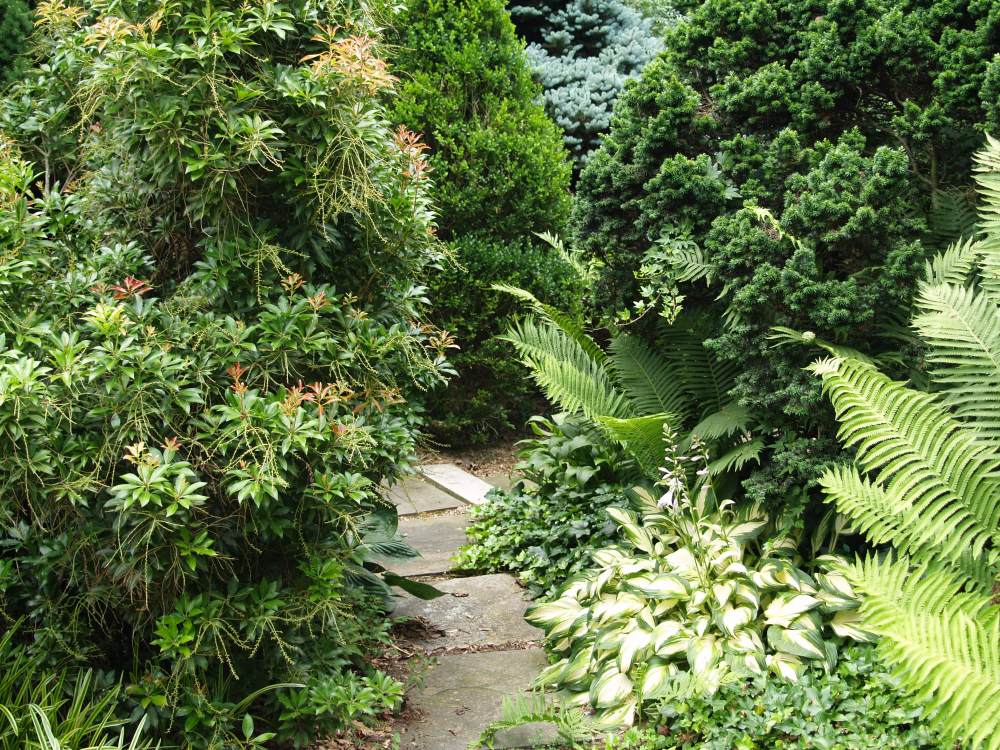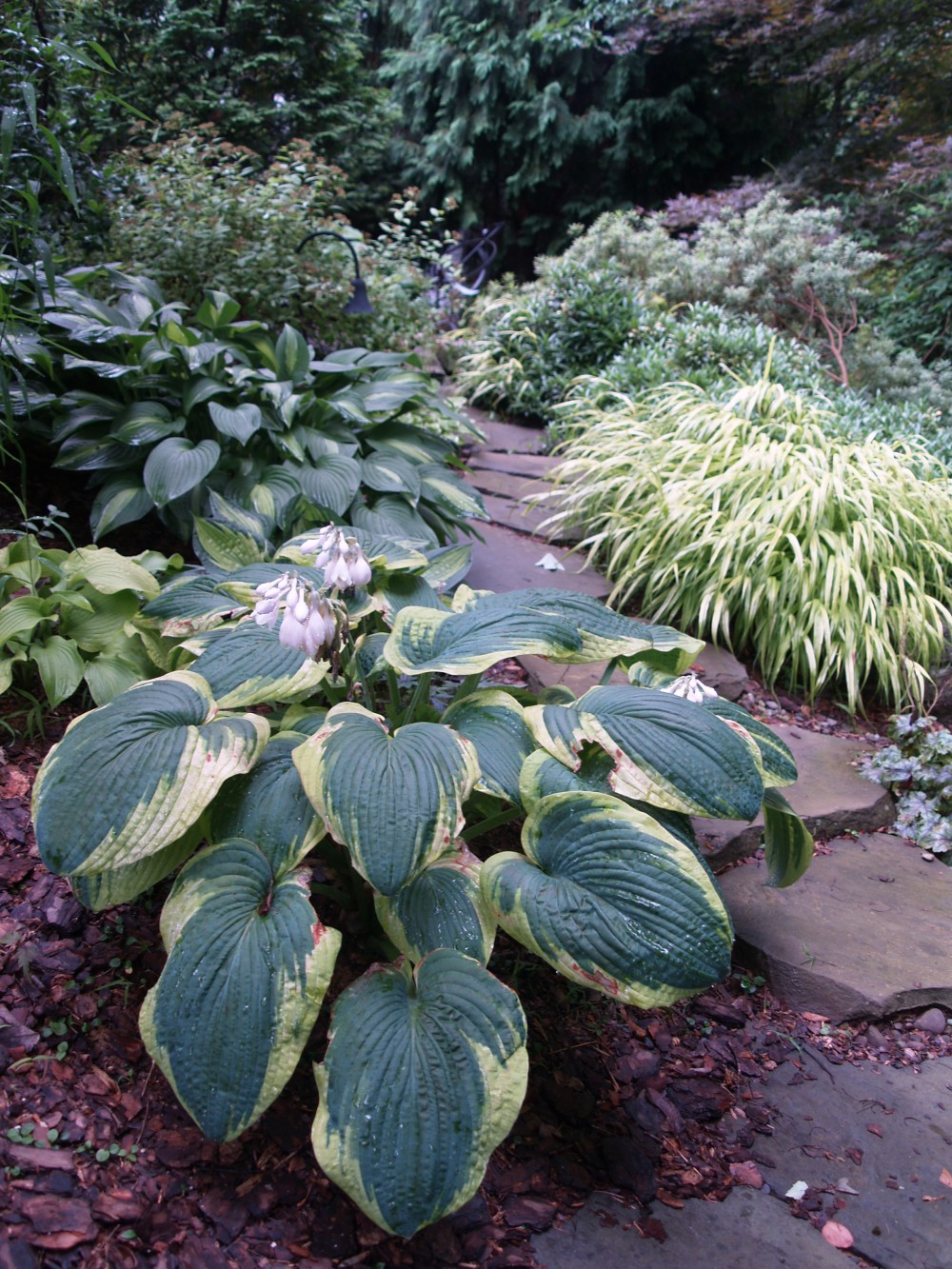Occasionally, my wife becomes “disturbed” about one thing or the other in the garden, usually that plants are flopping over and obstructing the stone paths that wander through the garden. I learned long ago that telling her not to come outside doesn’t work, and after a period of inaction on my part she usually threatens to remedy the problem herself. Several times I’ve come around the corner to find her armed, pruners in hand, and this is my cue to do something, anything to keep her from mutilating the unfortunate branches that have strayed.
A year ago I tackled the problem of the path that runs along the southern edge of the house that had vanished beneath huge hostas, tall nandinas that arched over, and a prickly mahonia that had grown in width to snag any passersby. I split and transplanted the hostas so that they are now half the size, and the offending branches of the nandinas and mahonia (below) were pruned so that the change in form is hardly noticed. The fix has improved the situation to some extent, but it is made much easier since my wife seldom ventures in this direction.
Now, she has expressed her concern that the driveway is disappearing. Both of us drive small cars, and I’ll admit that to reach the top of the drive requires veering a bit to the right around the Jane magnolia and fernspray cypress, then left to avoid the Japanese maple. Somewhere in there the caryopteris has strayed onto the asphalt, and I haven’t pruned the needlepoint ivy since I don’t when, though it’s the smallest part of the “problem”. Not that I think that it’s a problem at all, and I see some advantage in dissuading delivery trucks from even attempting to pull into the driveway.
A disadvantage is that the tree service and landscape clean up guys who go door-to-door make a beeline to our house, figuring there’s a goldmine in this obviously out-of-control garden. When I tell them that I do what they do, but I’ve been a little busy, they shake their head and hike back through the jungle to their truck. The truth is, I’m not too busy, I just don’t like a manicured garden, and I don’t mind brushing past wet branches or evil, thorny mahonias when I stroll through the garden.
Perhaps a few things have been planted too close to the paths, and others have grown more vigorously than I expected, but this isn’t a formal garden. If you visit expecting to see fine stonework with plants that gently taper to the path’s edge, you’ll be disappointed. I’ve taken care to construct the paths artfully in only a few areas, and most of the paths are stones randomly placed one after the other with no idea that anyone would care to look at anything but the plants.
Most often visitors stick to the few slate patios that are good vantage points for a general overview of the garden without expending too much effort (or shedding blood) to explore more deeply. Parts of the garden are accessed only by passing through ankle deep muck, and I’ve considered adding stepping stones through to these areas, but I’m the only person who’s been back there in years, so why bother? I don’t care if I carry a bit of mud back up to the house, and it’s rare that I don’t clean my work sandals before going inside. If I drag a bit of the garden into the house, that’s real trouble.
Mahonia! I’ve noticed that plant around here (Raleigh area) and wondered what it was. I think it’s a gorgeous thing. I also like kousa dogwood, so maybe it’s a symmetry thing? Thanks for giving me thename so I can go purchase and figure out where to put it on our tiny tiny lot.
Mahonia bealei is sometimes called leatherleaf mahonia. It is an early spring bloomer, which are followed by bunches of small grape-like fruits. It grows in a broadly spreading asymmetrical form.
I also grow the hybrid Winter Sun mahonia that blooms here in late November into December (and sometimes into the start of January). Its foliage is more prickly than leatherleaf mahonia, but it’s form is more compact and upright. Both are wonderful plants and I’ve planted several of each in sun and shade in the garden.
My goodness, your garden paths are gorgeous!! I am beginning to get excited now for Mid October and November. I usually treat myself to a new tree or such for the year. I ordered an American smoke tree. I am going to put it on the east side of home to give me some privacy. I have wanted one of these trees for 2 years now! I have read different heights, but mostly 20 to 30 feet and I believe about 20 feet wide, so I will move out diagonally from the fence and place it there when it comes middle of Oct. If you can tell me anything that you know of interest about this type of tree Dave I would appreciate any knowledge you can give me. I am in SC zone 8.
My weeping Lavender Twist red bud is hanging in there and I am still watching it closely and making sure that it has enough water. branches are still bendable and green. Maybe I shouldn’t be taking on another tree :0/
Beginning to also make a list of what I have to move in Nov. that is not doing well. will be the third time that I have to move the Rose of Sharon, it doesn’t seem to do well anywhere and hasn’t produced any flowers for two years! It is in full sun and planted it for my bearded dragon to eat it’s flowers… My dragon passed away after many years and it hasn’t produced flowers since, maybe an omen…
I sure am enjoying your blog and taking in all information and will continue to enjoy your beautiful pictures and stories.
I have a purple leafed European smokebush (Cotinus coggygria) in the garden, but I’ve planted it in shade that is too deep and the foliage is barely purple, and the blooms are hardly enough to notice. In full sun the foliage color is much deeper, and flowers are more abundant, but it grows like a weed with stems that go for eight or ten feet without branching. However, it apparently does not have a good fibrous root system, so it can be a bit troublesome to transplant.
I don’t have experience with American smokebush, but from references I would expect its growth habit to be similar.The habit of smokebush would be vastly improved with some pruning to keep a more compact form, but pruning large shrubs and trees can be difficult. Once established I would not fertilize or do anything to make it grow faster in hopes that it would remain more shrub-like. It seems to be an excellent choice for your part of the country, and it’s nice to use trees that are a bit out of the ordinary.
Yes Dave, I did read not to over water or fertilize. I am hesitant not to water much in the beginning because of my weeping lavender Twist Red bud and the problems I have had with it. I have red quite a bit about the American Smoke Tree which is not the purple one and have found that it is just larger in size and more colorful in the fall. It is rare I guess because it was harvested for the red orange/yellow dye under its bark. I guess it is actually called Cotinus Obovatus they say and not to be confused with the European Smoke Tree (whatever that means) Maybe that is the purple species… Grows two feet a year, drought tolerant, and can take any soil including rocky. I always amend soil though because of the clay here. From what I have found maybe there will be no trouble with this one. It will be 18 to 24 inches upon arrival. I just always have trouble knowing how far to plant away from things, but I think if I am at least 15 feet away from fence it will be fine. I guess that I shall see and maybe there is some information I can obtain on a proper way to plant it as in the hole and such. I know the root ball should be at least an inch above the soil and hole I think dug twice the size of the root ball? I shall continue to research. Thank you for your information I am glad that it is a good choice for this area and I am excited since I haven’t ever seen one around here…
I have been trying to find out if the roots of my smole bush could be invasive to my drainage system as it is close to my house.
I also have what I think from reading about your plants, which are beatiful I might add, is a nandina bush. (new foliage is pinkish) This plant is close to the house also.
It is very rare that roots of any plants pose a problem for water or drainage pipes, or for a house’s foundation. Weeping willows have been know to invade pipes that were already cracked, but roots will not routinely break through plastic, metal, or concrete pipes.